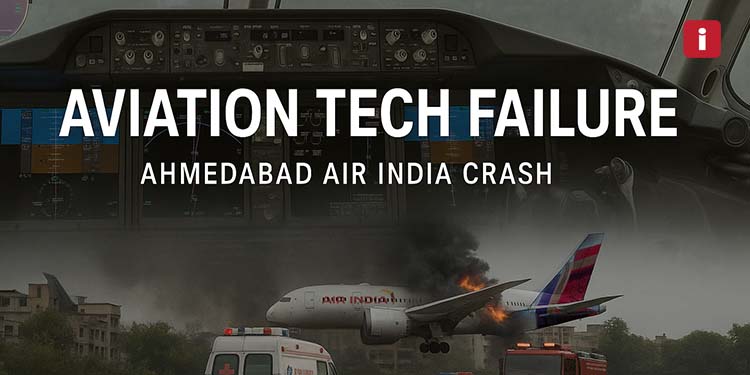Disaster on Air India Flight AI171 Sparks Global Level-I Tech Investigation
On June 12, 2025, an Air India Flight AI171, a Boeing 787-8 Dreamliner from Ahmedabad to London, crashed moments after takeoff. Inside were 241 souls; all perished, and at least 28 on the ground also died. The aircraft went down in a densely populated area near BJ Medical College hostel, leaving behind a trail of destruction and urgent queries about aviation safety and aircraft technology.
This remains the deadliest accident ever involving a Boeing 787 and is the worst air disaster in India for decades.
Now the entire world is focused on the technology systems in the plane, from its fly-by-wire control system to sensor input modules, black box data, and onboard automation.
Black Boxes Recovered | Analysis Goes Underway
AAIB, the Aircraft Accident Investigation Bureau of India, has confirmed that both FDR and CVR were recovered from the accident site and have been sent to New Delhi for decoding. These boxes will provide vital information regarding the final moments of the aircraft, such as speed, altitude, engine performance, and even conversation in the cockpit.
Preliminary information suggested the aircraft did not climb enough, stalled at an altitude of approximately 600 feet, and then dropped sharply. Among the causes being looked into are:
Misconfiguration of flaps or slats. Landing gear retraction delayed-unless there is another reason for it Sensor or avionics failure
Engine thrust anomalies during the takeoff roll.
Experts from the U.S. National Transportation Safety Board (NTSB) and Great Britain Air Accidents Investigation Branch (AAIB), Boeing, alongside GE Aerospace, have joined the probe with Indian authorities.
Boeing 787 Flight Systems Under Scrutiny
The Boeing 787 Dreamliner is a state-of-the-art aircraft with advanced fly-by-wire technology and intelligent sensor and partial automation systems to aid the pilot with real-time feedback in correcting flight paths and controlling precise engine performance.
Now, the investigators are looking into the situation where:
The aircraft was misled by sensor discrepancies to compute false altitude or airspeed.
A possible software glitch was responsible for errors in thrust application or flight configuration.
The GPWS issued warnings, or it failed to do so.
One official involved in the investigation stated that “The 787 depends extensively on sensor fusion and automated judgment through critical flight phases. If such an error or anomaly should occur in those first few seconds, it creates a cascading failure.”
Engines and Avionics Under the Microscope
The aircraft was powered with a pair of GEnx-1B engines, manufactured by GE Aerospace. While they have a good safety record, the engines are now the subject of a detailed forensic examination to check for mechanical or electronic failure.
Aviation engineers are also trying to look at whether there were faulty readings from telemetry from sensors embedded in the engine nacelles. Such a situation where sensors provide wrong data may have somehow led to the loss of lift on the flight.
GE Aerospace has stated its intention to fully cooperate with the authorities and mentioned there were no anomalies previously reported for this particular aircraft.
AI, automation and pilot interaction
Although it is not entirely autonomous, Boeing uses an AI-like system to help monitor flight parameters such as 787 pitch, Yava, gas adjustment and stability. Investigators focus on whether any of these systems:
Read the wrong terms of real -time due to incorrect sensor input.
Overrovpilot input incorrect.
Failed to notify the crew of configuration or stall risk.
Human-Machine interaction is one of the main themes. Did the crew depend on deficient data? Did the automatic aircraft system interpret the malfunction? It may take weeks to confirm the answer.
Analysis with high accident on the site
Crash Zone is mapped using Lidar scanners, drones and infrared imaging to produce 3D models of debris. Investigators also use AI software to analyze CCTV recording, satellite images and thermal readings before and after the event.
This is the first time an Indian accident site is being digitally rebuilt using Quantum Computing Resources. A team from Iit Gandhinagar helps model the dynamics of flight based on telemetry and acoustic data collected from nearby equipment.
Public reaction and global results
The accident has investigated Boeing’s security practice. The company, which is still struggling with recognized damage from 737 max, saw a decrease of about 9% in stock.
The Ministry of Civil Aviation of India announced a review of all Dreamliner aircraft operated by the Indian carrier. A special round table with aviation AI start -up and defense technology companies is scheduled to discuss domestic R&D June 20 in flight safety systems.
An aviation policy analyst in Bengaluru, Dr. Anjali Mehta, said, “This event has highlighted our extreme uniqueness of imported aviation technology.” “We need a Homegron system for auditing, verification and protection of the aircraft performance in the Indian airspace.”
Looking on | Responsibility and innovation
What went wrong on the AI171 is still coming out – but what is certain is that technology will play a key role in highlighting the truth. From sensor diagnostics and AI attachment paths to black-box algorithm and system design responsibility, the future of air safety is now depending on the software and system as much as on steel and skill.
For India’s aviation sector, this tragedy can be a significant turn: one that requires innovation, regulation and openness in equal measurements.
Insight Tech Talk will continue to track the effect of this study and global aviation and aerospace technology landscape.













































